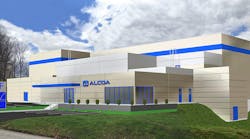Global lightweights leader Alcoa announced significant expansion to its research and development center on Thursday that will improve and advance its additive manufacturing materials and processes.
The $60 million project will include an additive manufacturing center near the company’s operational headquarters in New Kensington, Pa., about 30 miles northeast of downtown Pittsburgh, that will focus on processes, product design and qualification. The company will also produce additive materials for aerospace, automotive, medical, and building and construction.
“Combining our expertise in metal alloys, manufacturing, design and product qualification we will push beyond the limits of today’s additive manufacturing,” chairman and CEO Klaus Kleinfeld said. “This investment strengthens our leadership position in meeting fast-growing demand for aerospace components made using additive technologies.”
Among the processes that will be pioneered at the new center is Alcoa’s trademarked Ampliforge process, which the company introduced Thursday. The process combines “advanced materials, designs and additive and traditional manufacturing processes.” According to a company release, Ampliforge includes 3-D printing a nearly complete part, then treating it with a traditional manufacturing process.
Alcoa claims Ampliforge enhances additive properties, including strength and toughness, compared to traditionally 3-D printed parts. The process will be rolled out in the Pittsburgh and Cleveland areas.
Alcoa will also aim to advance additive at the center by certifying new 3-D printed parts, starting with aerospace, and producing proprietary aluminum, titanium and nickel powders designed especially for 3-D printing.
“The (alloy) powders need to be improved upon, they need to be cost effective, and they need to work better in the additive printing process,” CTO Ray Kilmer told Reuters. “What's new now is the machines are getting better, faster and cheaper.”
A mix of financial support and tax abatements from the state, the county, the township and the local school district will save the project an estimated $10 million. Construction is expected to be finished during the first quarter of next year, with 100 new fulltime positions in place by 2017.



